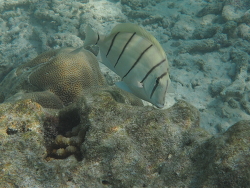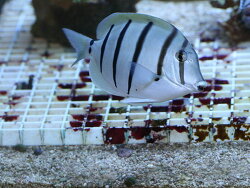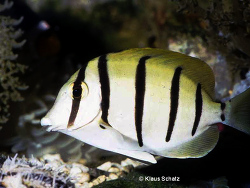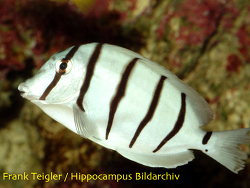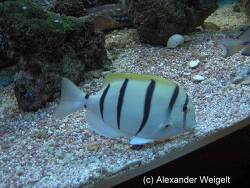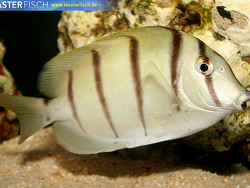Info
Acanthurus triostegus (Linnaeus, 1758)
Convict surgeonfish often assemble in large schools consisting of up to 1000 specimen. It can be found above hard substrates in depths up to 90 m.
It is a peaceful species. Accustomed to captivity as juvenile, it is a very beautiful fish for medium- and large-sized tanks. A very good algae eater.
Unfortunately often large, almost grown-up specimen are being imported which have difficulties in acclimatizing.
Convict surgeonfish grow very fast.
fishbase: Reports of ciguatera poisoning
The surgeonfishes (Acanthuridae), popular in marine aquaristics, are also called surgeonfishes.
They have horn-like blades in front of the tail root, they use as mainly defensive weapon (defense) against predators, but this sharp weapon is also used in fights among themselves.
Deep cuts in the body of opponents can cause permanent injuries, but often death occurs immediately.
If surgeonfishes are to be kept in pairs in an aquarium, fights between the fishes can be the order of the day, we could observe this several times with the very popular Hawaiian surgeonfish (Zebrasoma flavescens).
The scalpel-like blades can cause deep cuts, this is also true for the careless aquarist who wants to touch or catch the fish with unprotected hands.
Another problem can occur if one wants to catch surgeonfish with a landing net and transfer them after catching, the horn blade can easily get caught in the net.
Caution: Careless handling of the animal can cause deep cuts!
Synonymised names
Acanthurus hirudo Bennett, 1829 · unaccepted
Acanthurus hirundo Bennett, 1829 · unaccepted (junior synonym)
Acanthurus pentazona Bleeker, 1850 · unaccepted
Acanthurus sandvicensis Streets, 1877 · alternative representation
Acanthurus subarmatus Bennett, 1840 · unaccepted
Acanthurus triastegus (Linnaeus, 1758) · unaccepted (misspelling)
Acanthurus triostegus marquesensis Schultz & Woods, 1948 · unaccepted
Acanthurus triostegus sandvicensis Streets, 1877 · unaccepted (synonym)
Acanthurus triostegus triostegus (Linnaeus, 1758) · unaccepted
Acanthurus triostegust (Linnaeus, 1758) · unaccepted (misspelling)
Acanthurus zebra Lacepède, 1802 · unaccepted
Chaetodon couaga Lacepède, 1802 · unaccepted
Chaetodon triostegus Linnaeus, 1758 · unaccepted
Harpurus fasciatus Forster, 1801 · unaccepted
Hepatus sandvicensis (Streets, 1877) · unaccepted
Hepatus triostegus (Linnaeus, 1758) · unaccepted
Rhombotides pentazona (Bleeker, 1850) · unaccepted
Rhombotides triostegus (Linnaeus, 1758) · unaccepted
Teuthis australis Gray, 1827 · unaccepted
Teuthis elegans Garman, 1899 · unaccepted
Teuthis sandvicensis (Streets, 1877) · unaccepted
Teuthis triostegus (Linnaeus, 1758) · unaccepted
Teuthis troughtoni Whitley, 1928 · unaccepted
Direct children (4)
Subspecies Acanthurus triostegus marquesensis Schultz & Woods, 1948 accepted as Acanthurus triostegus (Linnaeus, 1758)
Subspecies Acanthurus triostegus polyzona (Bleeker, 1868) accepted as Acanthurus polyzona (Bleeker, 1868)
Subspecies Acanthurus triostegus sandvicensis Streets, 1877 accepted as Acanthurus triostegus (Linnaeus, 1758) (synonym)
Subspecies Acanthurus triostegus triostegus (Linnaeus, 1758) accepted as Acanthurus triostegus (Linnaeus, 1758)
Convict surgeonfish often assemble in large schools consisting of up to 1000 specimen. It can be found above hard substrates in depths up to 90 m.
It is a peaceful species. Accustomed to captivity as juvenile, it is a very beautiful fish for medium- and large-sized tanks. A very good algae eater.
Unfortunately often large, almost grown-up specimen are being imported which have difficulties in acclimatizing.
Convict surgeonfish grow very fast.
fishbase: Reports of ciguatera poisoning
The surgeonfishes (Acanthuridae), popular in marine aquaristics, are also called surgeonfishes.
They have horn-like blades in front of the tail root, they use as mainly defensive weapon (defense) against predators, but this sharp weapon is also used in fights among themselves.
Deep cuts in the body of opponents can cause permanent injuries, but often death occurs immediately.
If surgeonfishes are to be kept in pairs in an aquarium, fights between the fishes can be the order of the day, we could observe this several times with the very popular Hawaiian surgeonfish (Zebrasoma flavescens).
The scalpel-like blades can cause deep cuts, this is also true for the careless aquarist who wants to touch or catch the fish with unprotected hands.
Another problem can occur if one wants to catch surgeonfish with a landing net and transfer them after catching, the horn blade can easily get caught in the net.
Caution: Careless handling of the animal can cause deep cuts!
Synonymised names
Acanthurus hirudo Bennett, 1829 · unaccepted
Acanthurus hirundo Bennett, 1829 · unaccepted (junior synonym)
Acanthurus pentazona Bleeker, 1850 · unaccepted
Acanthurus sandvicensis Streets, 1877 · alternative representation
Acanthurus subarmatus Bennett, 1840 · unaccepted
Acanthurus triastegus (Linnaeus, 1758) · unaccepted (misspelling)
Acanthurus triostegus marquesensis Schultz & Woods, 1948 · unaccepted
Acanthurus triostegus sandvicensis Streets, 1877 · unaccepted (synonym)
Acanthurus triostegus triostegus (Linnaeus, 1758) · unaccepted
Acanthurus triostegust (Linnaeus, 1758) · unaccepted (misspelling)
Acanthurus zebra Lacepède, 1802 · unaccepted
Chaetodon couaga Lacepède, 1802 · unaccepted
Chaetodon triostegus Linnaeus, 1758 · unaccepted
Harpurus fasciatus Forster, 1801 · unaccepted
Hepatus sandvicensis (Streets, 1877) · unaccepted
Hepatus triostegus (Linnaeus, 1758) · unaccepted
Rhombotides pentazona (Bleeker, 1850) · unaccepted
Rhombotides triostegus (Linnaeus, 1758) · unaccepted
Teuthis australis Gray, 1827 · unaccepted
Teuthis elegans Garman, 1899 · unaccepted
Teuthis sandvicensis (Streets, 1877) · unaccepted
Teuthis triostegus (Linnaeus, 1758) · unaccepted
Teuthis troughtoni Whitley, 1928 · unaccepted
Direct children (4)
Subspecies Acanthurus triostegus marquesensis Schultz & Woods, 1948 accepted as Acanthurus triostegus (Linnaeus, 1758)
Subspecies Acanthurus triostegus polyzona (Bleeker, 1868) accepted as Acanthurus polyzona (Bleeker, 1868)
Subspecies Acanthurus triostegus sandvicensis Streets, 1877 accepted as Acanthurus triostegus (Linnaeus, 1758) (synonym)
Subspecies Acanthurus triostegus triostegus (Linnaeus, 1758) accepted as Acanthurus triostegus (Linnaeus, 1758)







 Jim Greenfield, Großbritannien
Jim Greenfield, Großbritannien






















































